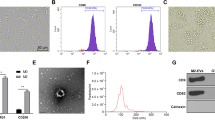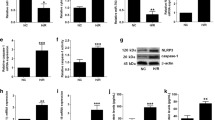Abstract
To investigate the mechanism by which hypoxia-reoxygenation (HR) mediates macrophage polarization to the M1 phenotype and then mediates cardiomyocyte (CM) pyroptosis through exosome release. Mouse bone marrow macrophages and CMs were cultured in vitro under hypoxia for 12 h and reoxygenation for 6 h to establish an HR cell model. qPCR was used to detect the M1 or M2 macrophage markers IL-1β, TNF-α, MR, and Arg, and a macrophage and CM coculture system was then established. Macrophages were transfected with an exosome-CD63-red fluorescent protein (RFP) lentivirus, allowing secretion of exosomes expressing RFP, and GW4869 was used to inhibit exosome release by macrophages. qPCR detected miR-29 expression in macrophage-derived exosomes, and macrophages were transfected with miR-29a inhibitors to obtain exosomes with low miR-29a expression (siR-exos). Pyroptosis indicators were detected by Western blot and ELISA. Importantly, LPS induced bone marrow macrophage polarization to the M1 type as a positive control to further verify that these exosomes (LPS-exos) regulated CM pyroptosis by delivering miR29a. Dual luciferase reporter and Western blot assays were adopted to analyze the miR-29a and MCL-1 target relationship. In addition, MCL-1 overexpression was used as a rescue experiment to determine whether miR-29a regulates pyroptosis in CM by targeting MCL-1. Macrophages expressed the M1 macrophage markers IL-1β and TNF-α after HR exposure. After CM coculture, RFP expression was significantly higher in the HR group than in the normal (Nor) group but significantly reduced in the GW4869 group. Immunofluorescence showed that caspase-1 mRNA and protein expression in the HR group was significantly higher than that in the Nor group (P < 0.05). Caspase-1 expression was significantly decreased in the GW4869 group compared with the HR group (P < 0.05). Western blotting showed that the pyrolysis-related NLRP3 and ASC protein expression levels were significantly upregulated in the HR group compared with the control (Ctr) and Nor groups (P < 0.05). However, GW4869 effectively inhibited pyroptosis-related protein expression (P < 0.05). In addition, ELISA showed that the expression of the inflammation indicators IL-1β and IL-18 was significantly increased in the HR group compared to the Ctr group (P < 0.05) but decreased in the GW4869 group (P < 0.05). qPCR showed that miR-29a was upregulated in the HR group compared to the Nor group. Moreover, HR-induced exosomes (HR-exos) from macrophages exacerbated HR-induced CM pyroptosis, while inhibition of miR-29a in exosomes partially offset CM pyroptosis induction. LPS-exos promoted pyroptosis-related protein expression, as the IL-1β and IL-18 concentrations were increased in the LPS-exos group. However, pyroptosis-related proteins were observably decreased, and IL-1β and IL-18 were also significantly decreased after miR-29a inhibition when compared with that in the HR-exos and LPS-exos groups. Mcl-1 overexpression reversed miR-29a-mediated CM pyroptosis in an HR environment. HR treatment induced macrophage polarization towards the M1 phenotype, which mediated CM pyroptosis through exosomal miR-29a transfer by targeting MCL-1.







Similar content being viewed by others
References
Bajpai G, Bredemeyer A, Li W, Zaitsev K, Koenig AL, Lokshina I, Mohan J, Ivey B, Hsiao HM, Weinheimer C, Kovacs A, Epelman S, Artyomov M, Kreisel D, Lavine KJ (2019) Tissue resident CCR2- and CCR2+ cardiac macrophages differentially orchestrate monocyte recruitment and fate specification following myocardial injury. Circ Res 124(2):263–278
Dai Y, Wang S, Chang S, Ren D, Shali S, Li C, Yang H, Huang Z, Ge J (2020) M2 macrophage-derived exosomes carry microRNA-148a to alleviate myocardial ischemia/reperfusion injury via inhibiting TXNIP and the TLR4/NF-κB/NLRP3 inflammasome signaling pathway.J Mol Cell Cardiol 142
Deng W et al (2016) miR-21 reduces hydrogen peroxide-induced apoptosis in c-kit(+) cardiac stem cells in vitro through PTEN/PI3K/Akt signaling. Oxidative Med Cell Longev 2016:5389181
Dick SA, Macklin JA, Nejat S, Momen A, Clemente-Casares X, Althagafi MG, Chen J, Kantores C, Hosseinzadeh S, Aronoff L, Wong A, Zaman R, Barbu I, Besla R, Lavine KJ, Razani B, Ginhoux F, Husain M, Cybulsky MI, Robbins CS, Epelman S (2019) Self-renewing resident cardiac macrophages limit adverse remodeling following myocardial infarction. Nat Immunol 20:29–39
Ding S, Liu D, Wang L, Wang G, Zhu Y (2020) Inhibiting microRNA-29a protects myocardial ischemia-reperfusion injury by targeting SIRT1 and suppressing oxidative stress and NLRP3-mediated pyroptosis pathway. J Pharmacol Exp Ther 372(1):128–135
Epelman S, Liu PP, Mann DL (2015) Role of innate and adaptive immune mechanisms in cardiac injury and repair. Nat Rev Immunol 15(2):117–129
Fan Q, Tao R, Zhang H, Xie H, Lu L, Wang T, Su M, Hu J, Zhang Q, Chen Q, Iwakura Y, Shen W, Zhang R, Yan X (2019) Dectin1 contributes to myocardial ischemia/reperfusion injury by regulating macrophage polarization and neutrophil infiltration. Circulation 139:663–678
Garcia NA, JM A, Sepulveda P, Diez-Juan A (2016) Cardiomyocyte exosomes regulate glycolytic flux in endothelium by direct transfer of GLUT transporters and glycolytic enzymes.Cardiovasc Res 1093(3)
Heo MJ, Kim TH, You JS, Blaya D, Sancho-Bru P, Kim SG (2019) Alcohol dysregulates miR-148a in hepatocytes through FoxO1, facilitating pyroptosis via TXNIP overexpression. Gut 68(4):708–720
Li C, Jin Y, Wei S, Sun Y, Jiang L, Zhu Q, Farmer DG, Busuttil RW, Kupiec-Weglinski JW, Ke B (2019) Hippo signaling controls NLR family pyrin domain containing 3 activation and governs immunoregulation of mesenchymal stem cells in mouse liver injury. Hepatology 70(5):1714–1731
Luo T, Fu J, Xu A, Su B, Ren Y, Li N, Zhu J, Zhao X, Dai R, Cao J, Wang B, Qin W, Jiang J, Li J, Wu M, Feng G, Chen Y, Wang H (2016) PSMD10/gankyrin induces autophagy to promote tumor progression through cytoplasmic interaction with ATG7 and nuclear transactivation of ATG7 expression. Autophagy 12(8):1355–1371
Mao Q, Liang XL, Zhang CL, Pang YH, Lu YX (2019) LncRNA KLF3-AS1 in human mesenchymal stem cell-derived exosomes ameliorates pyroptosis of cardiomyocytes and myocardial infarction through miR-138-5p/Sirt1 axis. Stem Cell Res Ther 10(1):393
Nazir S, Gadi I, al-Dabet M’M, Elwakiel A, Kohli S, Ghosh S, Manoharan J, Ranjan S, Bock F, Braun-Dullaeus RC, Esmon CT, Huber TB, Camerer E, Dockendorff C, Griffin JH, Isermann B, Shahzad K (2017) Cytoprotective activated protein C averts Nlrp3 inflammasome-induced ischemia-reperfusion injury via mTORC1 inhibition. Blood 130(24):2664–2677
Simões FC, Cahill TJ, Kenyon A, Gavriouchkina D, Vieira JM, Sun X, Pezzolla D, Ravaud C, Masmanian E, Weinberger M, Mayes S, Lemieux ME, Barnette DN, Gunadasa Rohling M, Williams RM, Greaves DR, Trinh LA, Fraser SE, Dallas SL, Choudhury RP, Sauka-Spengler T, Riley PR (2020) Macrophages directly contribute collagen to scar formation during zebrafish heart regeneration and mouse heart repair. Nat Commun 111(1)
Vince JE, de Nardo D, Gao W, Vince AJ, Hall C, McArthur K, Simpson D, Vijayaraj S, Lindqvist LM, Bouillet P, Rizzacasa MA, Man SM, Silke J, Masters SL, Lessene G, Huang DCS, Gray DHD, Kile BT, Shao F, Lawlor KE (2018) The mitochondrial apoptotic effectors BAX/BAK activate caspase-3 and -7 to trigger NLRP3 inflammasome and caspase-8 driven IL-1beta activation. Cell Rep 25(9):2339–2353 e4
Wang C, Zhang C, Liu L, A X, Chen B, Li Y, du J (2017) Macrophage-derived mir-155-containing exosomes suppress fibroblast proliferation and promote fibroblast inflammation during cardiac injury. Mol Ther 25(1):192–204
Wang Y, Zhao R, Liu D, Deng W, Xu G, Liu W, Rong J, Long X, Ge J, Shi B (2018) Exosomes derived from miR-214-enriched bone marrow-derived mesenchymal stem cells regulate oxidative damage in cardiac stem cells by targeting CaMKII. Oxidative Med Cell Longev 2018:4971261
Wang Y, Zhao RZ, Chen PK, Xu GX, Liu ZJ, Long XP, Qiu ZM, Shi B (2019a) Impact and related mechanism on the improvement of hyperglycemia-induced pyroptosis in H9c2 cells by mircoRNA-214. Zhonghua Xin Xue Guan Bing Za Zhi 47(10):820–828
Wang Y, Zhao R, Liu W, Wang Z, Rong J, Long X, Liu Z, Ge J, Shi B (2019b) Exosomal circHIPK3 released from hypoxia-pretreated cardiomyocytes regulates oxidative damage in cardiac microvascular endothelial cells via the miR-29a/IGF-1 pathway. Oxidative Med Cell Longev 2019:1–28
Yang F, Qin Y, Wang Y, Li A, Lv J, Sun X, Che H, Han T, Meng S, Bai Y, Wang L (2018) LncRNA KCNQ1OT1 mediates pyroptosis in diabetic cardiomyopathy. Cell Physiol Biochem 50(4):1230–1244
Zhu J, Tian Z, Li Y, Hua x, Zhang d, Li J, Jin H, Xu J, Chen W, Niu B, Wu X‐R, Comincini S, Huang H, Huang C (2019) ATG7 promotes bladder cancer invasion via autophagy-mediated increased ARHGDIB mRNA stability. Advanced science (Weinheim, Baden-Wurttemberg, Germany) 6(8):1801927
Ethics Statement
The study was approved by the Clinical Ethical Committee of the Affiliated Hospital of Zunyi Medical University. All experimental procedures were conducted in accordance with the ethical guidelines for the study of experimental pain in conscious animals.
Funding
The study was supported by a scientific research project from the National Natural Science Foundation of China (grant nos. 81860061, 81760042 and 81660049) and the Science and Technology Department of Guizhou Province (LH [2017] 7107). This work is also supported by the High-level Person-time Training Project in Guizhou Province (LH [2015] 4025), the Master Research Startup Foundation (no. [2016] 51) and the Guizhou Province Graduate Scientific Research Project (Qianjiaohe YJSCXJH [2018] 025).
Author information
Authors and Affiliations
Contributions
Yan Wang, Zhimei Qiu, and Bei Shi designed the study and wrote the manuscript. Jinson Yuan, Chaofu Li, Weiwei Liu, Wenwen Deng, and Ning Gu performed the experiments. Ranzun Zhao and Wei Zhang analyzed the data and obtained the results. Shan Hu and Zhixun Bai made the illustrations.
Corresponding author
Ethics declarations
Conflict of Interest
The authors declare that they have no conflict of interest.
Additional information
Editor: Tetsuji Okamoto
Rights and permissions
About this article
Cite this article
Wang, Y., Qiu, Z., Yuan, J. et al. Hypoxia-reoxygenation induces macrophage polarization and causes the release of exosomal miR-29a to mediate cardiomyocyte pyroptosis. In Vitro Cell.Dev.Biol.-Animal 57, 30–41 (2021). https://doi.org/10.1007/s11626-020-00524-8
Received:
Accepted:
Published:
Issue Date:
DOI: https://doi.org/10.1007/s11626-020-00524-8




